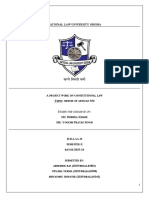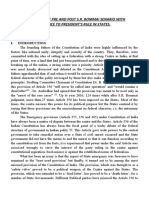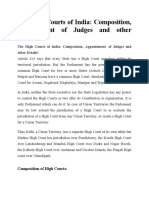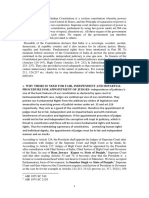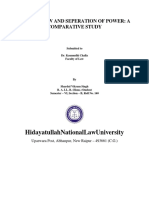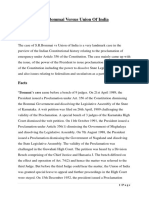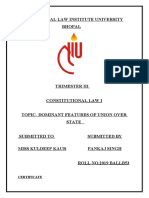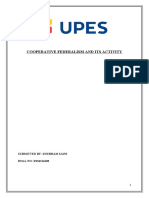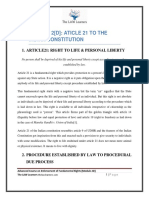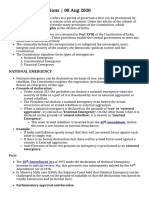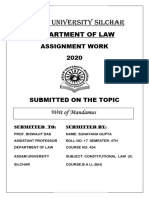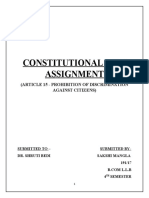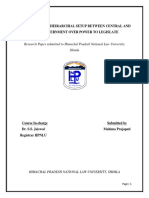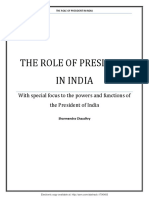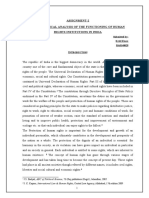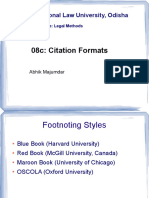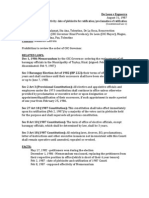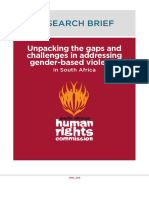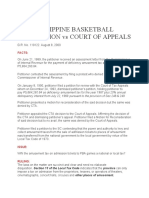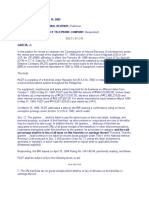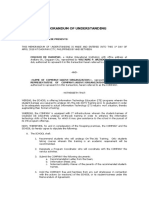Centre-State Relations - Anisha Singh
Uploaded by
anishaCentre-State Relations - Anisha Singh
Uploaded by
anishaPOWER OF STATE GOVERNMENT TO NOT IMPLEMENT
CENTRAL LAW IN STATE: A CRITICAL ANALYSIS
ABSTRACT
The Citizenship Amendment Act 2019 recently enacted by the union parliament is fundamentally
discriminatory and has been enacted aiming to target India’s largest minority community i.e.
Muslims. Shockingly the latest CAA seeks to grant citizenry rights to religious minorities of
neighbouring countries on the basis of religion, which is in a general sense unrealistic and
furthermore against the Article 14 of the Indian Constitution. The reasonable classification
safeguard taken by the legislature is not legitimate under the eyes of law. It is not a “reasonable
classification” but a “class legislation” in fact and therefore fundamentally wrong and
unconstitutional. Moreover, the CAA also hits Preamble, Article 15, 25, 29 and 30 of the Indian
Constitution besides Article 51C and Article 253 that makes an obligation to India to respect
international law in its true spirit.
After the implementation of CAA, there started a lot of hullabaloo in the country. Some of the
states explicitly denied the implementation of CAA. But constitutionally speaking, there is no
way a state can deny the implementation of the Citizenship Amendment Act (CAA) when it is
already passed by the Parliament. One can oppose it; by passing a resolution in the Assembly
and ask the central government to withdraw it. Kerela was the first state government to challenge
the act and to pass a resolution against the law. Following the southern footsteps, there is Kerela,
Madhya Pradesh, West Bengal and Maharahstra which joined the line. In the light of the same,
the author has tried to put emphasis on centre-state relations under the purview of Indian
constitution and its comparative analysis with other common law countries.
INTRODUCTION TO ARTICLE 365
In the Draft Constitution of India, various provisions empowering the Union Government to give
directions to the States during normal occasions just as during crises were proposed to be
incorporated. However, the draft was quiet with regards to the nature and degree of the power to
be given on the Union to guarantee that these directions were carried out effectively. To fill this
hole1 the Drafting Committee incorporated a new Article 365 which runs as follows:
“Article 365: Where any State has failed to comply with, or to give effect to, any directions given
in the exercise of the executive power of the Union under any of the provisions of this
Constitution, it shall be lawful for the President to hold that a situation has arisen in which the
Government of the State cannot be carried on in accordance with the provisions of this
Constitution.”
In understanding the nature and the extent of the power vested in the President by Article 365 the
manner utilized in this article to be dissected further. The significant words in this respect are as
follows, “any directions given in the exercise of the executive powers of the Union under any of
the provisions of this Constitution”. At the end of the day the significance of the expression “any
direction” must be comprehended to imply that any directions gave under any of the provisions
of this Constitution in the activity of the executive power of the Union2.
(1) Any direction is given by the Union in the legitimate exercise of its power under any of the
provisions of the Constitution; and
(2) Such direction has not been followed or given impact by the State.
The words “it shall be lawful for the President to hold” occurring in Article 365 don’t impose a
commitment or an obligation. They just confer power, the activity of which involves discretion
with the President. On each non-compliance with the Union direction, regardless of its degree
and significance, the President (as a result of the Council of Ministers) will undoubtedly hold
that a circumstance has emerged in which the Government of the non-complying State can’t be
carried on as per the Constitution.
The President should practice this drastic power in a sensible way with due consideration and
circumspection, and not mechanically. He should give due thought to every applicable or
relevant situation, including the reaction and response, assuming any, of the State Government to
the direction. Because of the direction, the State Government may fulfill the President that the
1
B. Shiva Rao, “The Framing of India’s Constitution: A Study” 822 (1968).
2
Krishna P. Shetty, “President’s Power under Article 356 of the Constitution - Theory and Practice ” 322 in Alice
Jacob (ed.): Constitutional Developments since Independence (1975).
direction had been given on wrong certainties or falsehood, or that the necessary remedy has
been affected. The President ought to likewise remember that each lead one to hold that the
immaterial abnormality from the constitutional path or a technical contravention of constitutional
provisions by the functionaries of the State Government would not really and sensibly lead one
to hold that the Government in the State can’t be carried on as per the Constitution.
In this manner, Article 365 goes about as a screen to forestall any hasty resort to the drastic
activity under Article 356 in case of disappointment with respect to a State Government to
follow or to provide impact to any constitutional direction given in the activity of the executive
power of the Union. In this way, the remarkable powers under Article 365 are important yet
ought to be practiced with extraordinary caution and in outrageous cases.3
Clarifying the importance of Article 365 Sawant, J. in S.R. Bommai v. Union of India4 observed
that Article 365 is more in the idea of an esteeming provision. He further expressed that inability
to conform to or to offer impact to the directions given by the Union under any of the provisions
of the Constitution is one of the circumstances mulled over by the expression “Government of
the State cannot be carried on in accordance with the provisions of this Constitution” occurring
in Article 356.
Dismissing the contention that the main situation where the power under Article 356 can be
invoked by the President is the failure of the State Government to conform to or to offer impact
to the directions given in the activity of the executive power of the Union under any of the
provisions of the Constitution and in no other case, Jeevan Reddy, J. seen that Article 365 is an
“permissible” provision. It just sets out one occasion in which the President may hold that the
Government of the State can’t be carried on as per the provisions of the Constitution. It can’t be
perused as exhaustive of the situation where the President may form the said fulfillment. He
contemplated that the expression, “it shall be lawful for the President” occuring in Article 365
vests discretionary power in the President which must be practiced decently. Every single failure
“ipso facto” doesn’t offer raise to the imperative circumstance examined by Article 356. The
President has to judge in each case whether the requisite satisfaction has arisen or not.5
3
Sarkaria Commission Report on Centre-State Relations 106-07 Part I (New Delhi: Government of India: 1988).
4
S.R. Bommai v. Union of India (1994) 3 SCC 1 at 104.
5
Id at 273.
The Sarkaria Commission cited the following illustrations as an indication of break-down of the
constitutional machinery in a State due to non-compliance with the directions issued by the
Union Government.6
1. Where a direction gave by the Union in the activity of its executive power under any of the
provisions of the Constitution, for example, Articles 256, 257 and 339(2) or, during a
crisis/emergency under Article 353, isn’t conformed to by the State Government disregarding
satisfactory admonition and opportunity, and the President immediately holds under Article 365
that a circumstance, for example, as contemplated about in Article 356 has emerged;
2. In the event that public order of any extent endangering the security of the State, happens, it is
the obligation of the State Government to keep the Union Government educated regarding such
issue and if the State neglects to do as such, such disappointment may add up to obstructing the
activity of the executive power of the Union Government and latter giving appropriate directions
under Article 257(1). If that such a direction given to the State by the Union Executive under
Article 257(1) isn’t followed notwithstanding satisfactory admonition, the President immediately
may hold that the circumstance, for example, examined in Article 356 has emerged.
RESEARCH QUESTIONS
What is the legal standing of different reports of the committee regarding the non-
compliance of the state government?
What are the different provisions in the Indian Constitution in which Union Government
can issue directions to the State Government?
What would happen if there is a violation of legal rights of the state by the state/centre?
What is the position of other common law countries in this regard?
ARTICLE 365 AND THE CONSTITUENT ASSEMBLY DEBATES
Article 365 was brought into the Constitution at the revision stage only 11 days before the
Constitution was adopted by the Constituent Assembly. This provision was broadly talked about
in 1949 in the Assembly. In the Constituent Assembly, a few individuals restricted this article
6
Supra note 3 at 173.
vehemently. Pt. H.N. Kunzru maintained this new article was not justified by the terms of
reference to the Drafting Committee and that the Committee went past its command. When Dr.
B.R. Ambedkar looked to justify the adoption of Article 365 by making a reference to Section
126 of the Government of India Act, 19357, Pt. H.N. Kunzru said that while embracing certain
provisions of the Government of India Act, 1935 into the Draft Constitution, a few provisions of
that Act were intentionally overlooked inferring along these lines that Section 126 was one such
arrangement which was excluded while preparing the Draft Constitution. Advocating for the
cancellation of Article 365, he unequivocally maintained that reference to Section 126 of the
Government of India Act, 1935, right now, not legitimize the language of Article 365.
Pt. Thakurdas Bhargava, contending that Article 365 is redundant, said that if the Provincial
Government will not maintain a significant provision of the Constitution much after the
Government of India gave the directions to the Provincial Governments to abide by it, at that
point the language of Article 356 is adequate to address the issues of such a situation. Supporting
for the deletion of Article 365 he clarified the effect of this article on the stability of the
Provincial Governments in the accompanying words:
“The Provincial Governments will be in constant fear and will constantly tremble before him (the
Prime Minister). Such a provision will invest the Central Government with absolutely arbitrary
power and I maintain that arbitrary power should not be given to any person. Ministers and
Provincial Governments will have no security or stability and will change at the whim or caprice
of the Prime Minister.”
However, the inclusion of Article 365 was bolstered by different Members of the Assembly on
the ground that the Center ought to be sufficient and it ought to have a solid command over the
Provincial Governments to hold over the challenges made by the fissiparous propensities existing
in the nation. Defending Article 365, Dr. B.R. Ambedkar saw that the new article contained a
“consequential provision” on the grounds that: “... once there is power given to the Union
Government to issue directions to the States that in certain matters they must act in a certain way,
it seems to me that not to give the Centre the power to take action when there is failure to carry
out those directions is practically negative the directions which the Constitution proposes to give
7
Section 126, The Government of India Act 1935.
to the Centre. Every right must be followed by a remedy. If there is no remedy then obviously
the right is purely a paper right, a nugatory right which has no meaning, no sense and no
substance.”
THE SIGNIFICANCE OF ARTICLE 365
The incorporation of Article 365 in the Constitution isn’t without importance. The Constitution
has not accommodated separate federal agencies to execute federal laws. If the Union is to
execute them through the State Government by giving directions to them, the Union must have a
vital capacity to look for compliance from the States for the execution of Union directions. To
accomplish this target power is given to the President under Article 365. But, inconsiderate
utilization of these directions can disturb the constitutional harmony between the Union-State
relationships.8
R.S. Gae has proposed that Parliament could, in case that where the State has neglected to carry
on the directions provided by it, pass a law enabling the Central Government to call upon the
State Ministers and the authorities of the State to actualize the directions given by the Union
Government and impose a punishment/penalty for inability to do as such. To accomplish this
reason he is supportive of invoking Article 258(2). In the event that this proposal is followed, at
that point Article 365, subsequently, Article 356 need not be invoked. According to his opinion
recourse to Article 365 can be had just if the State Legislature explicitly restricts the Ministry
from actualizing the Union direction.9
However, this proposal was opposed by the Rajmannar Committee on the explanation that as per
Gae’s recommendation the Cabinet would be dependent upon two experts and ought to be
mindful to both, viz. the Central Government and the State Legislature. The Committee opined
this is an incomprehensible situation under the constitutional provisions. Further, the Rajmannar
Committee communicated the view that the most objectionable component as to Articles 256 and
257 is that the main condition to be fulfilled before the issue of such directions is the unilateral
fulfillment of the Government of India, as both the articles (Article 256 and 257) contained the
8
P.B. Mukherji, “The Critical Problems of the Indian Constitution” 28 (1968).
9
Vol. III R.S. Gae, “Administrative Relations between the Union and the States” 10-14 (1969).
expression “such directions to a State as may appear to the Government of India to be vital for
that reason”.
In this way, this Committee pushed for the annulment of Articles 256, 257 and 365. Then again
this Committee proposed that if these articles are to be retained, no direction contemplated in
Articles 256 and 257 ought to be given except in consultation with and with the endorsement of
the Inter-State Council.10 It is presented that the view taken by the Rajmannar Committee is
confounded in light of the fact that the Constitution built up a capable government in which the
executive, that is the Cabinet, is made dependable to the legislature. Essentially, the established
constitutional provision made the State Government response to the Central Government so far
as the union directions are concerned.
UNION DIRECTIONS UNDER THE CONSTITUTION
Under different provisions of the Constitution, the Union Government is approved to give
directions to the States which would have the effect of infringing upon the State field in an
overabundance of that allowed by the plan or scheme of the Constitution.
Article 53 of the Constitution provides that the executive power of the Union is vested in the
President and he shall exercise his power either directly or through officials subordinate to him
as per the provisions of the Constitution. Article 73 says that the executive power of the Union
broadens (a) to issues regarding which the Parliament has the power to make laws; and (b) to the
exercise of such rights, authority and locale as are exercisable by the Government of India by the
virtue of any treaty or agreement. As such the executive power of the Union understands the
ability to manage or to convey into impact the legitimate laws made by Parliament and the
activity of its treaty powers.
Article 256 imposes a general commitment on the States to practice their executive power as to
guarantee consistency with the laws made by Parliament and the executive power of the Center
reaches out to the giving of such directions to a State as may appear to the Center to be important
for the reason11. This makes the State executive subservient to the Union’s executive power.
10
Report of the Centre-State Relations Enquiry Committee 22-23 (Madras: Government of Tamil Nadu: 1971).
11
Jay Engineering Works Ltd. v. State of W.B., (AIR 1968 Cal 407).
Article 257(1) gives that the executive power of the State is to be so practiced as not to impede
the activity of the Center’s executive power and the Center can give such directions to a State as
may appear to the Central Government to be fundamental for that reason.
Under Article 257(2) the Center may provide directions to a State with regards to the
development and maintenance of methods for correspondence proclaimed toward the path to be
of national or military significance, despite the fact that “communications” is a State subject.
However, this doesn’t confine the power of Parliament to pronounce highways or waterways to
be national; nor is the Center’s power is limited as for the national highways or waterways nor its
power to build and keep up methods for correspondence as a major aspect of its functions
concerning maritime, military and aviation-based works.
Article 257(3) enables the Center to give directions to a State with regards to the measures to be
taken for the protection of the Railways within the State. “Railways” is a Central subject
however “police” is a State subject. Thus the protection of railway property exists in the field of
the State Government. It might be that in a specific case the Center may want that the railway
property is secured by taking extraordinary measures by the State and for that reason, the Center
is given the power to offer directions to the States 12. Article 257(4) provides that the Center will
pay sums to the States in regard to additional expenses brought about by the States for
consenting to the directions given by the Center under Article 257(2) and (3).
At the point when a proclamation of emergency is made under Article 352 the executive power
of the Union stretches out to the giving of directions to any State with regards to the way where
the executive power thereof is to be worked out. This is conceivable by virtue of Article 353(a).
At the point when a financial emergency is proclaimed under Article 360 the Center may provide
directions to a State, inter alia, to observe certain groups of financial appropriateness by
prudence of Article 360(3).
Notwithstanding the above provision, in specific issues concerning minorities and language
additionally, the Central Government has the power to give directions to the States. Under
Article 339(2) the Central Government is engaged to provide directions to a State with regards to
12
M.P. Jain, “Indian Constitutional Law” 352-53 (1987).
the drawing up and execution of plans determined toward the path to be basic for the welfare of
the Scheduled Tribes in the State.
Article 344(6) empowers the President to give directions to provide impact to the proposal of the
Language Commission [appointed under Article 344(1)] after they were scrutinized by a
Parliamentary Committee.
Under Article 347, on request being made for that sake, the President may, on the off chance that
he is fulfilled that a considerable segment of a State wants the utilization of any language
verbally expressed by them to be perceived by that State, direct that such language will likewise
be authoritatively perceived all through the State or any part thereof for such reason as he may
determine.
Under Article 350-A a State is committed to offering facilities for guidance in the native
language at the primary phase of children having a place with a linguistic minority and the
President has been engaged to issue such directions to any State as he thinks necessary. Under
para 6 of the Fifth Schedule of the Constitution the President can proclaim areas/zones to be
scheduled areas and can provide directions with respect to the administration of these zones.
If that the Union Government gives any directions under any of the provisions identified above
and if any State Government neglects to follow them, such failure answers the situation
examined by Article 365.
VIOLATION OF LEGAL RIGHTS OF THE STATE AND BY THE STATE/CENTRE
Article 131 provides exclusive jurisdiction on the Supreme Court in disputes including States, or
the Center from one viewpoint and at least one States on the other. This implies no other court
can engage in such a question. It is notable that both High Courts and the Supreme Court have
the ability to settle adjudicatory bodies against the State and Central governments. Specifically,
the legitimacy of any executive or legislative activity is typically tested by method for writ
petitions under Article 226 of the Constitution in regard of High Courts, and, in regard to
fundamental rights infringement, under Article 32 in the Supreme Court. In contrast to
individuals, State governments can’t whine of fundamental rights being violated. Along these
lines, the Constitution gives that at whatever point a State feels that its legal rights are under risk
or have been disregarded; “dispute” to the Supreme Court. States have documented such
arguments under Article 131 against neighboring States in regard to water sharing and boundary
questions. There have been examples of such cases being documented against the Center as well.
But, the provisions referenced in this article subject to different provisions of the Constitution,
i.e., if a solution for any issue is available under some other Article of the Constitution, at that
point this article won’t be accessible. For instance, in instances of water disputes between at least
two states, the solution for such clashes is engaged under Article 262 of the Constitution and not
under Article 131.
COMPARATIVE ANALYSIS OF OTHER NATIONS
In the United States, the two significant layers of government are at the state and national levels.
This framework, where more than one layer of government has jurisdiction over a similar
domain, is called federalism. In spite of the fact that it appears to be normal to US citizens that
the government is partitioned into different layers, truth be told, there are just 15 federal
republics on the planet. In the United States, the federalist framework developed on the grounds
that the states advanced from discrete colonies, which had diverse populaces and various needs.
The Framers of the Constitution envisioned that state governments, not the national government,
would be the principal unit of government for citizens on an everyday basis. Since federation, the
balance of power between levels of government has moved considerably from the founders’
vision.
For the initial two decades, Australian federalism remained sensibly consistent with the “co-
ordinate” vision of the framers13. In co-ordinate federalism, the Commonwealth and the States
were both financially and politically independent within their own circles of obligation. This was
strengthened by the High Court, which in various decisions in those early years dismissed
Commonwealth government endeavors to expand its power into areas of State jurisdiction.
Much distribution of power has been equivocal, prompting debates and disputes which have been
decided by the Judicial Committee of the Privy Council and (after 1949) the Supreme Court of
Canada. The idea of the Canadian constitution was portrayed by the Privy Council in 1913 as not
13
Leslie Zines, “The Federal Balance and the Position of the States”, 81 in Gregory Craven (ed.) The Convention
Debates 1891–1898: commentaries, indices and guide (1986).
genuinely federal (in contrast to the United States and Australia); despite the fact that the British
North America Act, 1867, states in its preamble that the provinces had communicated “their
desire to be federally joined into one Dominion”, “the literal interpretation of the word [federal]
limits its application to cases where these States while concurring on a proportion of delegation,
yet in the principle keep on safeguarding their unique Constitutions”. The Privy Council
confirmed that the Fathers of Confederation wanted a “general Government charged with issues
of basic interest and new and only nearby Governments for the Provinces”. Matters other than
those recorded in the British North America Act, 1867, as the duty of the federal or provincial
parliaments tumbled to the federal lawmaking body.14
CONCLUSIONS & RECOMMENDATIONS
In India, the Center-States relations establish the center components of the federalism. The
Central Government and State Government collaborate for the prosperity and security of the
residents of India. They have worked together in the field of natural security, fear control, family
control, and socio-economic planning. The Indian constitution target reconciling the national
solidarity while enabling to keep up state to the State governments. The facts confirm that the
association has been doled out bigger forces than the state governments, however this is an issue
of degree and not quality, since all the basic highlights of a federation are available in the Indian
constitution. It is frequently characterized to be quasi-federal in nature. Hence, it tends to be said
that the Indian Constitution is fundamentally federal in nature despite the fact that it has one of a
kind characteristics that empower it to accept unitary features upon the period of scarcity.
Federal however its soul and spirit are unitary.
From the foregoing analysis the following propositions would emerge:
1. The composers of the Constitution planned to make the Central Government sufficiently able
to hold over the challenges made by the fissiparous tendencies. Article 365, in their view, is one
of the measures to accomplish the said reason. At present the Indian polity is stood up to with
issues like parochial inclinations, nepotism, religious clashes, petty and insignificant political
14
The Attorney-General for Commonwealth of Australia and others v The Colonial Sugar Refining Company
Limited and others [1913] UKPC 76.
interests, cross-border terrorism notwithstanding political instability. Currently, Article 365 has a
task to carry out in light of a legitimate concern for the solidarity and uprightness of India.
2. The Union Government has no different organizations or agencies to actualize the Union laws.
Subsequently, the Union Government is given power under Article 365 to ensure consistency
with the Union directions from the State Governments. Henceforth this is one of the reasons for
which the power under Article 365 is to be utilized.
3. Article 365 is a permissible provision under which the President has a discretionary power to
decide whether a specific circumstance falls within the ambit of this article or not. He needs to
practice this discretionary power reasonably in order to restrict the extent of Article 365 by
taking into consideration the federal principle underlying the Constitution.
4. Dr B.R. Ambedkar said in the Constituent Assembly that before invoking the Presiden’s rule
provision by the Center, an admonition must be given to the erring State referencing that things
are not occurring in the manner by which they are planned to occur in the Constitution. If that the
Union Government gives any such admonition, at that point the non-compliance with such
warning by the State Government answers the circumstance as contemplated by Article 365.
You might also like
- An Analysis of Pre and Post S.R. Bommai Senario With Refrence To President'S Rule in StatesNo ratings yetAn Analysis of Pre and Post S.R. Bommai Senario With Refrence To President'S Rule in States7 pages
- Constitution Law Project On Misuse of Article 356No ratings yetConstitution Law Project On Misuse of Article 35614 pages
- Emergency Provisions in Indian Constitution100% (1)Emergency Provisions in Indian Constitution6 pages
- International Treaty Implementation by India To What Extent100% (1)International Treaty Implementation by India To What Extent16 pages
- Comparative Study of Separation of Power in India U.K. and U.S.a.No ratings yetComparative Study of Separation of Power in India U.K. and U.S.a.11 pages
- Hidayatullahnationallawuniversity: Rule of Law and Seperation of Power: A Comparative StudyNo ratings yetHidayatullahnationallawuniversity: Rule of Law and Seperation of Power: A Comparative Study33 pages
- India and Federalism: Holding Together or Coming Together Federation100% (1)India and Federalism: Holding Together or Coming Together Federation5 pages
- Cooperative Federalism and Its Activity: Submitted By: Shubham Saini ROLL NO: R154216103No ratings yetCooperative Federalism and Its Activity: Submitted By: Shubham Saini ROLL NO: R15421610330 pages
- Discretionary Powers of The President Under The Indian Constitution - Mrinal SatishNo ratings yetDiscretionary Powers of The President Under The Indian Constitution - Mrinal Satish11 pages
- Notes On 109 Constitutional Law Paper - Il - V1.5 - by Ketan BhattNo ratings yetNotes On 109 Constitutional Law Paper - Il - V1.5 - by Ketan Bhatt98 pages
- Financial Relation Between Centre and StateNo ratings yetFinancial Relation Between Centre and State4 pages
- Election Law: Jamia Millia Islamia University, New DelhiNo ratings yetElection Law: Jamia Millia Islamia University, New Delhi11 pages
- Powers and Functions of President in IndiaNo ratings yetPowers and Functions of President in India6 pages
- A Brief Study On: Mimangsa Principle of InterpretationNo ratings yetA Brief Study On: Mimangsa Principle of Interpretation14 pages
- Final ANALYSIS OF THE HEIRARCHIAL SETUP BETWEEN CENTRAL AND STATE GOVERNMENT OVER POWER TO LEGISLATENo ratings yetFinal ANALYSIS OF THE HEIRARCHIAL SETUP BETWEEN CENTRAL AND STATE GOVERNMENT OVER POWER TO LEGISLATE16 pages
- Doctrine of Harmonius Construction in Interpretation and Construction of StatutesNo ratings yetDoctrine of Harmonius Construction in Interpretation and Construction of Statutes12 pages
- Role of President in India - DessertationNo ratings yetRole of President in India - Dessertation41 pages
- The Doctrine of "Basic Structure" in The Indian Constitution A CritiqueNo ratings yetThe Doctrine of "Basic Structure" in The Indian Constitution A Critique32 pages
- Assignment-2 Topic: Critical Analysis of The Functioning of Human Rights Institutions in IndiaNo ratings yetAssignment-2 Topic: Critical Analysis of The Functioning of Human Rights Institutions in India10 pages
- Google AND Search-Engine Market Power: Harvard Journal of Law & Technology Occasional Paper Series - July 2013No ratings yetGoogle AND Search-Engine Market Power: Harvard Journal of Law & Technology Occasional Paper Series - July 201325 pages
- The Bhopal Disaster and Medical Research: PerspectivesNo ratings yetThe Bhopal Disaster and Medical Research: Perspectives4 pages
- ICDT 2018: International Conference On Digital TransformationNo ratings yetICDT 2018: International Conference On Digital Transformation8 pages
- Sovereign Citizen Extremist Ideology Report 2-5-15No ratings yetSovereign Citizen Extremist Ideology Report 2-5-157 pages
- G.R. No. 96016 October 17, 1991 Commissioner of Internal Revenue, Petitioner, vs. The Court of Appeals and Efren P. Castaneda, RespondentsNo ratings yetG.R. No. 96016 October 17, 1991 Commissioner of Internal Revenue, Petitioner, vs. The Court of Appeals and Efren P. Castaneda, Respondents1 page
- Telecommunication, Press and Media Laws Project On: Right To Advertise Commercial SpeechNo ratings yetTelecommunication, Press and Media Laws Project On: Right To Advertise Commercial Speech22 pages
- Employee Confidentiality, Protection of IP Rights and Non-Competition UndertakingNo ratings yetEmployee Confidentiality, Protection of IP Rights and Non-Competition Undertaking5 pages
- SAMPLE MEMORANDUM Agreement-for-Easement-of-Right-of-WayNo ratings yetSAMPLE MEMORANDUM Agreement-for-Easement-of-Right-of-Way3 pages
- Hartfield 1108 Appeal 13 14 00238 CV Reply FILED.20140620No ratings yetHartfield 1108 Appeal 13 14 00238 CV Reply FILED.2014062029 pages
- Batangas Laguna Tayabas Bus Company, Inc. vs. Court of AppealsNo ratings yetBatangas Laguna Tayabas Bus Company, Inc. vs. Court of Appeals9 pages
- Federal Insurance Company v. Project Control Systems, Incorporated Et Al - Document No. 7No ratings yetFederal Insurance Company v. Project Control Systems, Incorporated Et Al - Document No. 74 pages
- Philippine Basketball Association Vs Court of Appeals: FactsNo ratings yetPhilippine Basketball Association Vs Court of Appeals: Facts5 pages
- Gerald Lebovits - The Writing Process For New LawyersNo ratings yetGerald Lebovits - The Writing Process For New Lawyers6 pages
- The Common Law in The American Legal System100% (1)The Common Law in The American Legal System20 pages
- The Supremacy of EU Law and Its Reception in The Member StatesNo ratings yetThe Supremacy of EU Law and Its Reception in The Member States33 pages
- Chapter 4- INFORMATION ASSURANCE AND SECURITY LAWS AND ETHICSNo ratings yetChapter 4- INFORMATION ASSURANCE AND SECURITY LAWS AND ETHICS26 pages
- G.R. No. 193261 - Sabili v. Commission On ElectionsNo ratings yetG.R. No. 193261 - Sabili v. Commission On Elections10 pages
- Chapter 3. Banker Customer RelationshipNo ratings yetChapter 3. Banker Customer Relationship38 pages
- Adversarial and Inquisitorial Systems of TrialNo ratings yetAdversarial and Inquisitorial Systems of Trial8 pages
- Legal and Ethical Issues in Community Health Nursing100% (3)Legal and Ethical Issues in Community Health Nursing12 pages


